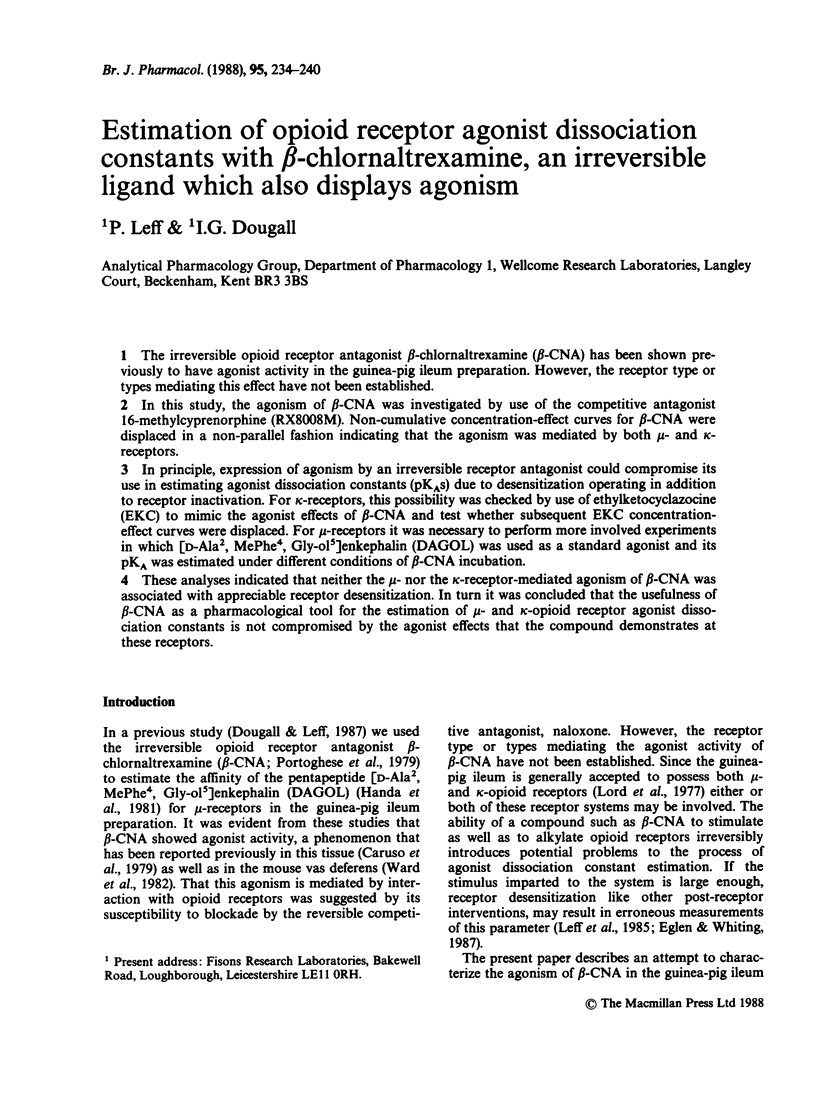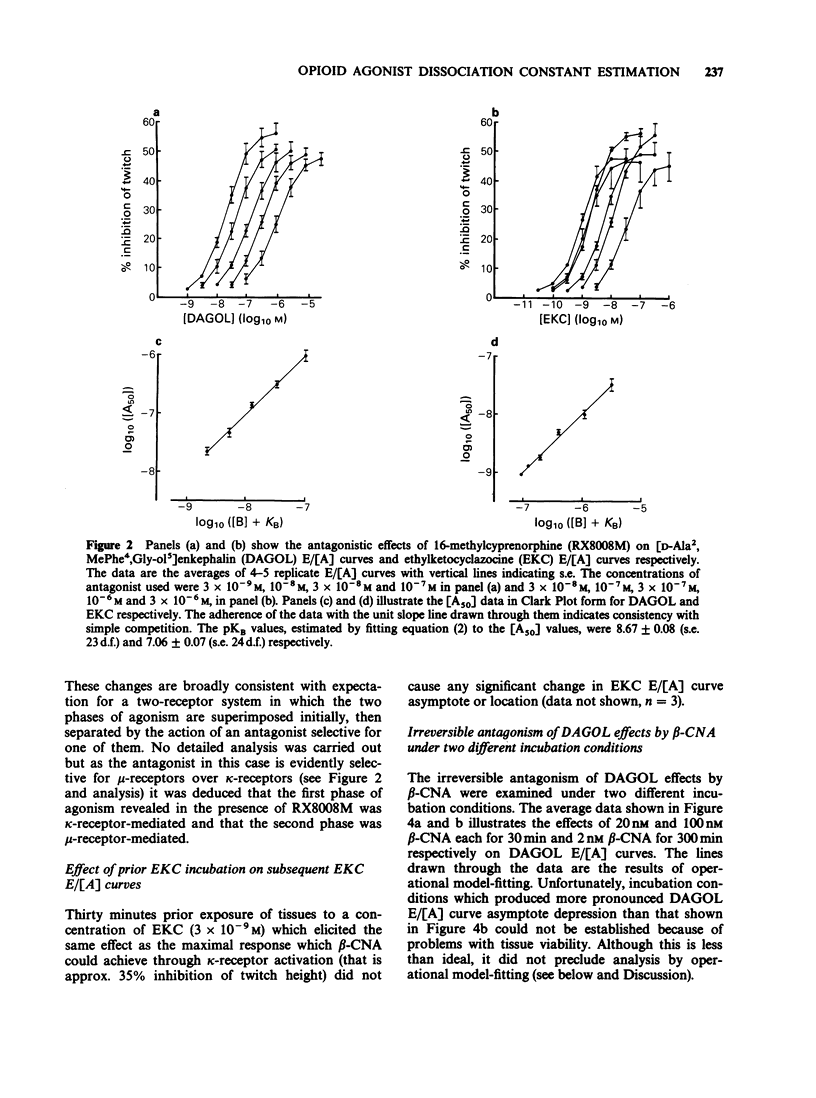Abstract
1. The irreversible opioid receptor antagonist beta-chlornaltrexamine (beta-CNA) has been shown previously to have agonist activity in the guinea-pig ileum preparation. However, the receptor type or types mediating this effect have not been established. 2. In this study, the agonism of beta-CNA was investigated by use of the competitive antagonist 16-methylcyprenorphine (RX8008M). Non-cumulative concentration-effect curves for beta-CNA were displaced in a non-parallel fashion indicating that the agonism was mediated by both mu- and kappa-receptors. 3. In principle, expression of agonism by an irreversible receptor antagonist could compromise its use in estimating agonist dissociation constants (pKAs) due to desensitization operating in addition to receptor inactivation. For kappa-receptors, this possibility was checked by use of ethylketocyclazocine (EKC) to mimic the agonist effects of beta-CNA and test whether subsequent EKC concentration-effect curves were displaced. For mu-receptors it was necessary to perform more involved experiments in which [D-Ala2, MePhe4, Gly-ol5]enkephalin (DAGOL) was used as a standard agonist and its pKA was estimated under different conditions of beta-CNA incubation. 4. These analyses indicated that neither the mu- nor the kappa-receptor-mediated agonism of beta-CNA was associated with appreciable receptor desensitization. In turn it was concluded that the usefulness of beta-CNA as a pharmacological tool for the estimation of mu- and kappa-opioid receptor agonist dissociation constants is not compromised by the agonist effects that the compound demonstrates at these receptors.
Full text
PDF






Selected References
These references are in PubMed. This may not be the complete list of references from this article.
- Black J. W., Leff P. Operational models of pharmacological agonism. Proc R Soc Lond B Biol Sci. 1983 Dec 22;220(1219):141–162. doi: 10.1098/rspb.1983.0093. [DOI] [PubMed] [Google Scholar]
- Black J. W., Leff P., Shankley N. P., Wood J. An operational model of pharmacological agonism: the effect of E/[A] curve shape on agonist dissociation constant estimation. Br J Pharmacol. 1985 Feb;84(2):561–571. doi: 10.1111/j.1476-5381.1985.tb12941.x. [DOI] [PMC free article] [PubMed] [Google Scholar]
- Caruso T. P., Takemori A. E., Larson D. L., Portoghese P. S. Chloroxymorphamine, and opioid receptor site-directed alkylating agent having narcotic agonist activity. Science. 1979 Apr 20;204(4390):316–318. doi: 10.1126/science.86208. [DOI] [PubMed] [Google Scholar]
- Dougall I. G., Leff P. Pharmacological analysis of the calcium-dependence of mu-receptor agonism. Br J Pharmacol. 1987 Dec;92(4):723–731. doi: 10.1111/j.1476-5381.1987.tb11376.x. [DOI] [PMC free article] [PubMed] [Google Scholar]
- Eglen R. M., Whiting R. L. Estimation of apparent agonist affinity constants using desensitization of the ileal muscarinic receptor. J Pharmacol Exp Ther. 1987 Feb;240(2):404–409. [PubMed] [Google Scholar]
- Handa B. K., Land A. C., Lord J. A., Morgan B. A., Rance M. J., Smith C. F. Analogues of beta-LPH61-64 possessing selective agonist activity at mu-opiate receptors. Eur J Pharmacol. 1981 Apr 9;70(4):531–540. doi: 10.1016/0014-2999(81)90364-2. [DOI] [PubMed] [Google Scholar]
- Leff P., Martin G. R., Morse J. M. Application of the operational model of agonism to establish conditions when functional antagonism may be used to estimate agonist dissociation constants. Br J Pharmacol. 1985 Jul;85(3):655–663. doi: 10.1111/j.1476-5381.1985.tb10561.x. [DOI] [PMC free article] [PubMed] [Google Scholar]
- Lord J. A., Waterfield A. A., Hughes J., Kosterlitz H. W. Endogenous opioid peptides: multiple agonists and receptors. Nature. 1977 Jun 9;267(5611):495–499. doi: 10.1038/267495a0. [DOI] [PubMed] [Google Scholar]
- Porreca F., Burks T. F. Affinity of normorphine for its pharmacologic receptor in the naive and morphine-tolerant guinea-pig isolated ileum. J Pharmacol Exp Ther. 1983 Jun;225(3):688–693. [PubMed] [Google Scholar]
- Portoghese P. S., Larson D. L., Jiang J. B., Caruso T. P., Takemori A. E. Synthesis and pharmacologic characterization of an alkylating analogue (chlornaltrexamine) of naltrexone with ultralong-lasting narcotic antagonist properties. J Med Chem. 1979 Feb;22(2):168–173. doi: 10.1021/jm00188a008. [DOI] [PubMed] [Google Scholar]
- Sayre L. M., Takemori A. E., Portoghese P. S. Alkylation of opioid receptor subtypes by alpha-chlornaltrexamine produces concurrent irreversible agonistic and irreversible antagonistic activities. J Med Chem. 1983 Apr;26(4):503–506. doi: 10.1021/jm00358a009. [DOI] [PubMed] [Google Scholar]
- Smith C. F. 16-Me cyprenorphine (RX 8008M): a potent opioid antagonist with some delta selectivity. Life Sci. 1987 Jan 19;40(3):267–274. doi: 10.1016/0024-3205(87)90342-0. [DOI] [PubMed] [Google Scholar]
- Trist D. G., Leff P. Quantification of H2-agonism by clonidine and dimaprit in an adenylate cyclase assay. Agents Actions. 1985 Apr;16(3-4):222–226. doi: 10.1007/BF01983145. [DOI] [PubMed] [Google Scholar]
- Ward S. J., Portoghese P. S., Takemori A. E. Pharmacological profiles of beta-funaltrexamine (beta-FNA) and beta-chlornaltrexamine (beta-CNA) on the mouse vas deferens preparation. Eur J Pharmacol. 1982 Jun 4;80(4):377–384. doi: 10.1016/0014-2999(82)90083-8. [DOI] [PubMed] [Google Scholar]


